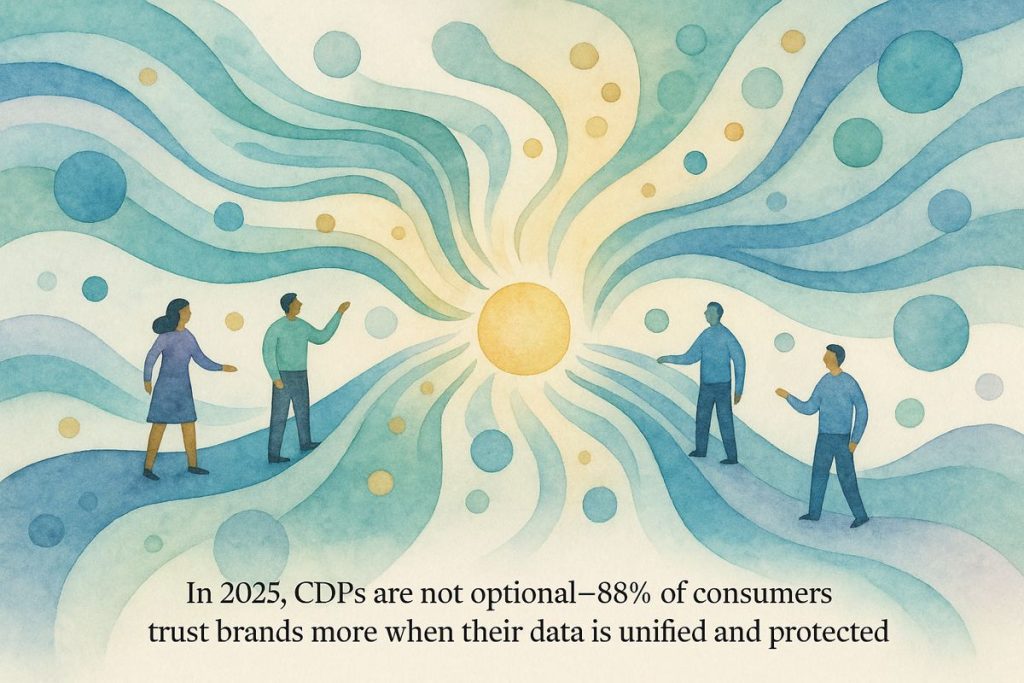In 2025, Customer Data Platforms (CDPs) have become the heart of business success, moving from a forgotten tool to an absolute must-have. They pull together all kinds of customer data, making it easy to see the full picture, follow strict rules, and build trust. Without a CDP, companies risk confusion, mistakes, and losing customers—especially when privacy rules are tougher than ever. For industries like life sciences, CDPs make sure data is accurate, safe, and always ready when needed, turning chaos into calm and giving teams super-clear vision.
Why are Customer Data Platforms (CDPs) considered essential for commercial excellence in 2025?
Customer Data Platforms (CDPs) are essential in 2025 because they unify fragmented customer data, ensure regulatory compliance, and enable real-time, holistic insights. This is crucial for commercial excellence, particularly in sectors like life sciences, where data accuracy, compliance, and trust are non-negotiable for success.
From Back-Office Afterthought to Mission Control
Let’s clear out the dusty cobwebs of 2021: back then, Customer Data Platforms (CDPs) were the sort of tool you might find languishing on an IT wishlist, right next to hoverboards and telepathy. Fast-forward to 2025, and CDPs have elbowed their way to the front of the line—now officially “Must Have” according to the MoSCoW prioritization framework. Not “should” or “could.” Must. (That’s not me yelling; it’s the official guidance.)
Why the sudden urgency? Consider this: last quarter, I watched a global pharma client panic when their fragmented data led to a regulatory near-miss. The smell of burnt coffee hung in the conference room as compliance teams scrambled to stitch together audit trails from five different systems. Not a scenario you want to relive. These days, such data chaos is simply anathema—especially in sectors like life sciences and pharmaceuticals, where every misstep leaves a trace as indelible as a red wine stain on a white shirt.
The MoSCoW method—originally minted by Dai Clegg and popularized by ProductPlan and Edstellar—has become the industry’s compass for navigating this complexity. It sorts priorities into “Must Have, Should Have, Could Have, Won’t Have.” In this new epoch, CDPs have finally, irrevocably, made the leap to “Must Have”—right up there with cybersecurity and a morning espresso.
MoSCoW: The Framework That Keeps You Sane
Honestly, it took me a while to warm up to MoSCoW. At first, it felt like yet another acronym in a sea of business jargon—until I saw a cross-functional team use it to slice through a spaghetti tangle of competing IT demands with surgical precision. MoSCoW’s strength is its ruthless simplicity: it forces you to ask, “If we don’t do this, what breaks?”
Nowhere is this more poignant than in the battle-scarred trenches of customer data management. In 2025, real-time, holistic insight into your customers is no longer negotiable. According to the CDP Institute, the global CDP market is expected to hit a cool $10.3 billion this year. That’s not a rounding error; that’s a tectonic shift.
This new status reflects a consensus: without unified data, you’re flying blind. For life sciences, the stakes are existential—one regulatory blunder, and you’re the next cautionary tale at a compliance conference. MoSCoW’s transparency aligns IT, marketing, compliance, and the C-suite on the necessity of CDPs—no more hand-waving or wishful thinking. It’s a bit like finally admitting you need glasses—suddenly, everything snaps into focus.
Why CDPs Rule the Data Roost
CDPs aren’t just glorified spreadsheets. They’re the hyperspectral lenses through which organizations view and orchestrate the entire customer journey. They ingest streams from CRM, web analytics, mobile apps, and even offline channels, piecing together a unified customer palimpsest—one that’s as textured as a well-worn Moleskine.
Here’s where things get spicy: with the imminent demise of third-party cookies (cue dramatic music), organizations are scrambling to maximize their first-party data. If you’re not aggregating, cleansing, and activating that data with a CDP, well… good luck. The likes of Salesforce CDP and Adobe Real-Time CDP have evolved as plug-and-play nervous systems for commercial, marketing, and service teams.
I’ll admit—I once underestimated the regulatory bite of GDPR and CCPA. (Who hasn’t?) Then, during a product demo, I watched a compliance officer’s face light up when a CDP showed instant consent tracking and audit logs. Relief is a palpable emotion—almost as sweet as hearing the hiss of a fresh espresso shot.
Compliance, Competition, and the Crunch for Trust
The regulatory environment is a roiling sea these days. Data privacy, consent management, audit trails—these aren’t just checkboxes; they’re survival tools. If your organization can’t demonstrate airtight handling of data subject rights, you’re toast. As HCL Software notes, CDPs are now the linchpins for not only commercial agility but also ironclad compliance.
Let’s not tiptoe around it: organizations lagging behind on CDP adoption are already feeling the squeeze. I recall a competitor who tried to fake it with patched-together APIs; the result was like duct-taping a Ferrari engine into a bicycle. Customers noticed. Churn followed—swift and brutal. According to recent surveys, 88% of consumers trust brands more when their data is treated with transparent respect. That trust, in 2025, is the currency of survival.
And the texture of this new world? Imagine dashboards glowing gently in a darkened control room, the low hum of servers, and the unmistakable scent of possibility—yes, that’s optimism you’re smelling.
Pharma, Life Sciences, and the Art of the Possible
Life sciences and pharma
